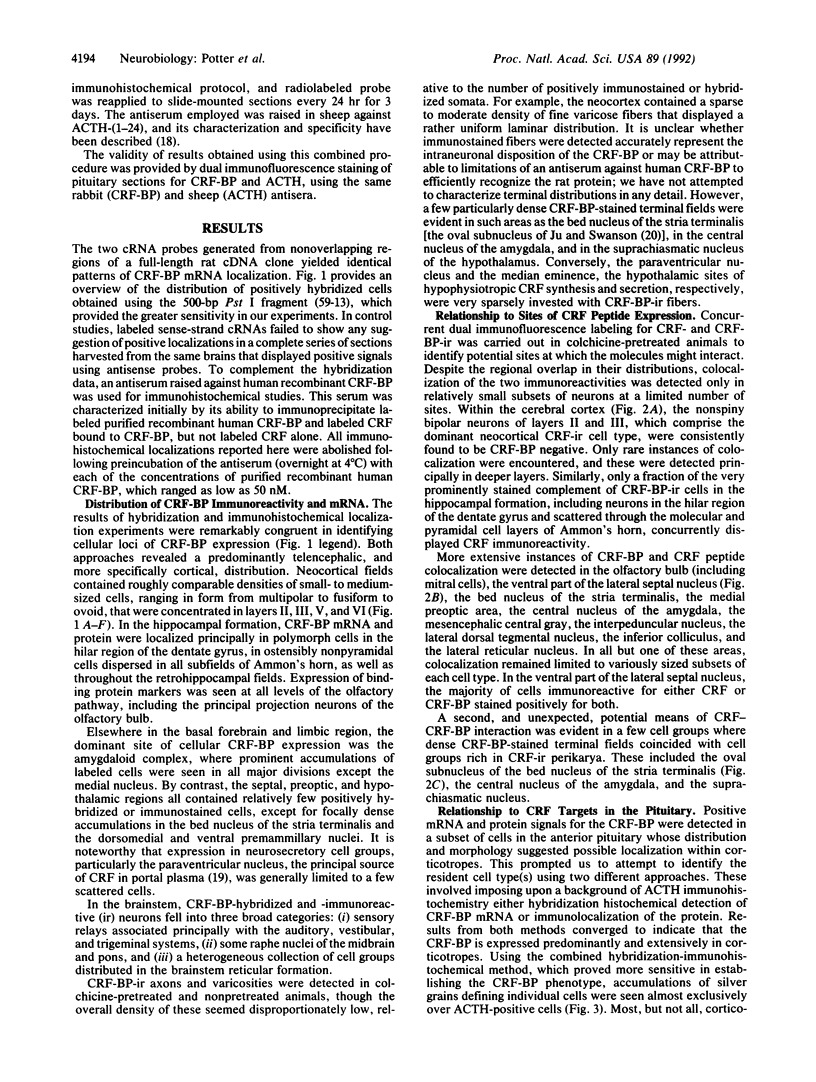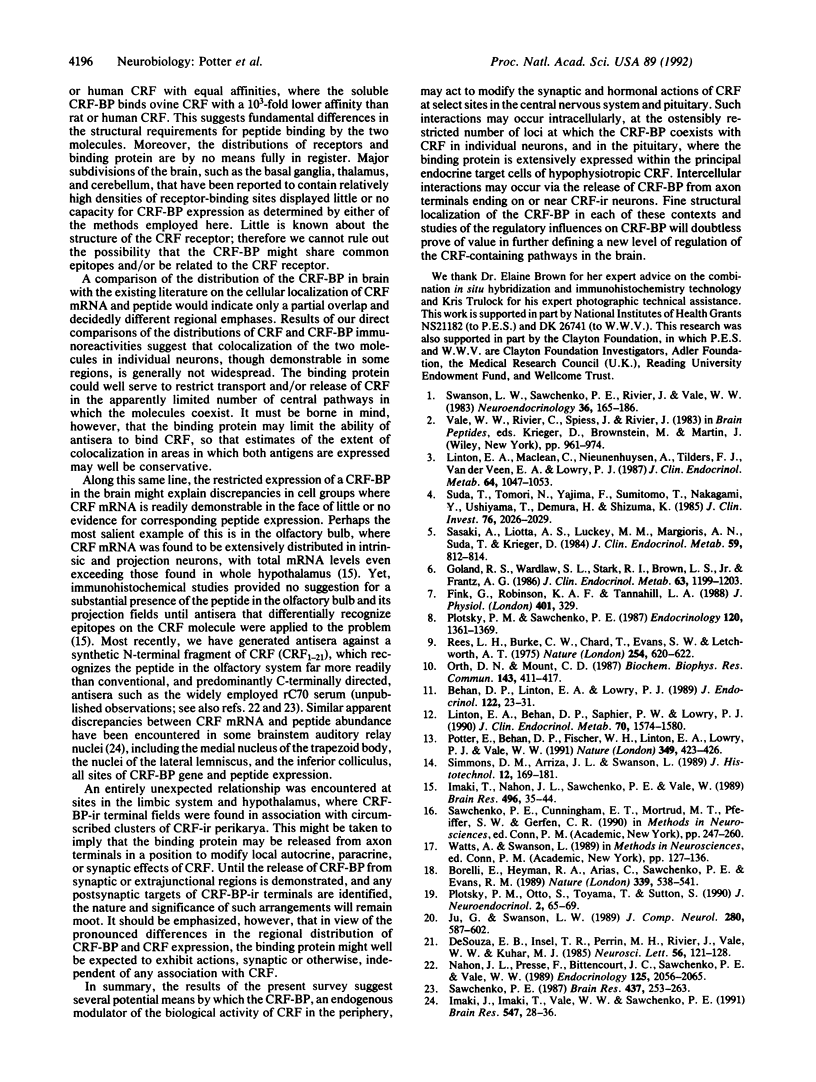Abstract
In recent studies to clone and characterize genes coding for the corticotropin-releasing factor-binding protein (CRF-BP), analysis of the tissue distribution of the CRF-BP gene indicated a high level of expression in the rat brain. We have now characterized by immunohistochemical and hybridization histochemical means the cellular localization of CRF-BP protein and mRNA expression, respectively. Results from both approaches converged to indicate that CRF-BP is expressed predominantly in the cerebral cortex, including all major archi-, paleo-, and neocortical fields. Other prominent sites of mRNA and protein expression include subcortical limbic system structures (amygdala, bed nucleus of the stria terminalis), sensory relays associated with the auditory, olfactory, vestibular, and trigeminal systems, severe raphe nuclei, and a number of cell groups in the brainstem reticular core. Expression in the hypothalamus appears largely limited to the ventral premammillary and dorsomedial nuclei; only isolated CRF-BP-stained cells are apparent in neurosecretory cell groups. Dual immunostaining for CRF and CRF-BP revealed a partial colocalization in some of these regions. In addition, prominent CRF-BP-stained terminal fields have been identified in association with CRF-expressing cell groups in circumscribed hypothalamic and limbic structures. In the anterior pituitary, CRF-BP mRNA and immunoreactivity were colocalized with corticotropin-immunoreactivity in a majority of corticotropes. Thus, CRF-BP could serve to modify the actions of CRF by intra- and intercellular mechanisms, in CRF-related pathways in the central nervous system and pituitary.
Full text
PDF




Images in this article
Selected References
These references are in PubMed. This may not be the complete list of references from this article.
- Behan D. P., Linton E. A., Lowry P. J. Isolation of the human plasma corticotrophin-releasing factor-binding protein. J Endocrinol. 1989 Jul;122(1):23–31. doi: 10.1677/joe.0.1220023. [DOI] [PubMed] [Google Scholar]
- Borrelli E., Heyman R. A., Arias C., Sawchenko P. E., Evans R. M. Transgenic mice with inducible dwarfism. Nature. 1989 Jun 15;339(6225):538–541. doi: 10.1038/339538a0. [DOI] [PubMed] [Google Scholar]
- De Souza E. B., Insel T. R., Perrin M. H., Rivier J., Vale W. W., Kuhar M. J. Differential regulation of corticotropin-releasing factor receptors in anterior and intermediate lobes of pituitary and in brain following adrenalectomy in rats. Neurosci Lett. 1985 May 14;56(2):121–128. doi: 10.1016/0304-3940(85)90117-x. [DOI] [PubMed] [Google Scholar]
- Fink G., Robinson I. C., Tannahill L. A. Effects of adrenalectomy and glucocorticoids on the peptides CRF-41, AVP and oxytocin in rat hypophysial portal blood. J Physiol. 1988 Jul;401:329–345. doi: 10.1113/jphysiol.1988.sp017165. [DOI] [PMC free article] [PubMed] [Google Scholar]
- Goland R. S., Wardlaw S. L., Stark R. I., Brown L. S., Jr, Frantz A. G. High levels of corticotropin-releasing hormone immunoactivity in maternal and fetal plasma during pregnancy. J Clin Endocrinol Metab. 1986 Nov;63(5):1199–1203. doi: 10.1210/jcem-63-5-1199. [DOI] [PubMed] [Google Scholar]
- Imaki J., Imaki T., Vale W., Sawchenko P. E. Distribution of corticotropin-releasing factor mRNA and immunoreactivity in the central auditory system of the rat. Brain Res. 1991 Apr 26;547(1):28–36. doi: 10.1016/0006-8993(91)90571-c. [DOI] [PubMed] [Google Scholar]
- Imaki T., Nahon J. L., Sawchenko P. E., Vale W. Widespread expression of corticotropin-releasing factor messenger RNA and immunoreactivity in the rat olfactory bulb. Brain Res. 1989 Sep 4;496(1-2):35–44. doi: 10.1016/0006-8993(89)91050-0. [DOI] [PubMed] [Google Scholar]
- Ju G., Swanson L. W. Studies on the cellular architecture of the bed nuclei of the stria terminalis in the rat: I. Cytoarchitecture. J Comp Neurol. 1989 Feb 22;280(4):587–602. doi: 10.1002/cne.902800409. [DOI] [PubMed] [Google Scholar]
- Linton E. A., Behan D. P., Saphier P. W., Lowry P. J. Corticotropin-releasing hormone (CRH)-binding protein: reduction in the adrenocorticotropin-releasing activity of placental but not hypothalamic CRH. J Clin Endocrinol Metab. 1990 Jun;70(6):1574–1580. doi: 10.1210/jcem-70-6-1574. [DOI] [PubMed] [Google Scholar]
- Linton E. A., McLean C., Nieuwenhuyzen Kruseman A. C., Tilders F. J., Van der Veen E. A., Lowry P. J. Direct measurement of human plasma corticotropin-releasing hormone by "two-site" immunoradiometric assay. J Clin Endocrinol Metab. 1987 May;64(5):1047–1053. doi: 10.1210/jcem-64-5-1047. [DOI] [PubMed] [Google Scholar]
- Nahon J. L., Presse F., Bittencourt J. C., Sawchenko P. E., Vale W. The rat melanin-concentrating hormone messenger ribonucleic acid encodes multiple putative neuropeptides coexpressed in the dorsolateral hypothalamus. Endocrinology. 1989 Oct;125(4):2056–2065. doi: 10.1210/endo-125-4-2056. [DOI] [PubMed] [Google Scholar]
- Orth D. N., Mount C. D. Specific high-affinity binding protein for human corticotropin-releasing hormone in normal human plasma. Biochem Biophys Res Commun. 1987 Mar 13;143(2):411–417. doi: 10.1016/0006-291x(87)91369-6. [DOI] [PubMed] [Google Scholar]
- Plotsky P. M., Sawchenko P. E. Hypophysial-portal plasma levels, median eminence content, and immunohistochemical staining of corticotropin-releasing factor, arginine vasopressin, and oxytocin after pharmacological adrenalectomy. Endocrinology. 1987 Apr;120(4):1361–1369. doi: 10.1210/endo-120-4-1361. [DOI] [PubMed] [Google Scholar]
- Potter E., Behan D. P., Fischer W. H., Linton E. A., Lowry P. J., Vale W. W. Cloning and characterization of the cDNAs for human and rat corticotropin releasing factor-binding proteins. Nature. 1991 Jan 31;349(6308):423–426. doi: 10.1038/349423a0. [DOI] [PubMed] [Google Scholar]
- Rees L. H., Burke C. W., Chard T., Evans S. W., Letchworth A. T. Possible placental origin of ACTH in normal human pregnancy. Nature. 1975 Apr 17;254(5501):620–622. doi: 10.1038/254620b0. [DOI] [PubMed] [Google Scholar]
- Sasaki A., Liotta A. S., Luckey M. M., Margioris A. N., Suda T., Krieger D. T. Immunoreactive corticotropin-releasing factor is present in human maternal plasma during the third trimester of pregnancy. J Clin Endocrinol Metab. 1984 Oct;59(4):812–814. doi: 10.1210/jcem-59-4-812. [DOI] [PubMed] [Google Scholar]
- Sawchenko P. E. Evidence for differential regulation of corticotropin-releasing factor and vasopressin immunoreactivities in parvocellular neurosecretory and autonomic-related projections of the paraventricular nucleus. Brain Res. 1987 Dec 29;437(2):253–263. doi: 10.1016/0006-8993(87)91641-6. [DOI] [PubMed] [Google Scholar]
- Suda T., Tomori N., Yajima F., Sumitomo T., Nakagami Y., Ushiyama T., Demura H., Shizume K. Immunoreactive corticotropin-releasing factor in human plasma. J Clin Invest. 1985 Nov;76(5):2026–2029. doi: 10.1172/JCI112204. [DOI] [PMC free article] [PubMed] [Google Scholar]
- Swanson L. W., Sawchenko P. E., Rivier J., Vale W. W. Organization of ovine corticotropin-releasing factor immunoreactive cells and fibers in the rat brain: an immunohistochemical study. Neuroendocrinology. 1983;36(3):165–186. doi: 10.1159/000123454. [DOI] [PubMed] [Google Scholar]





